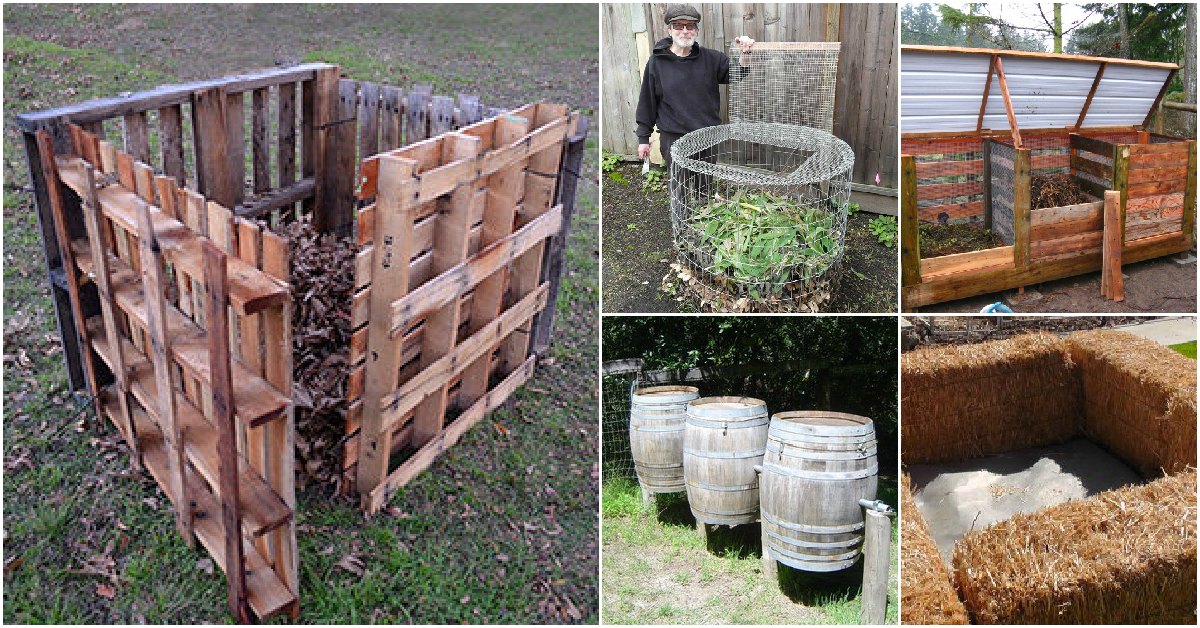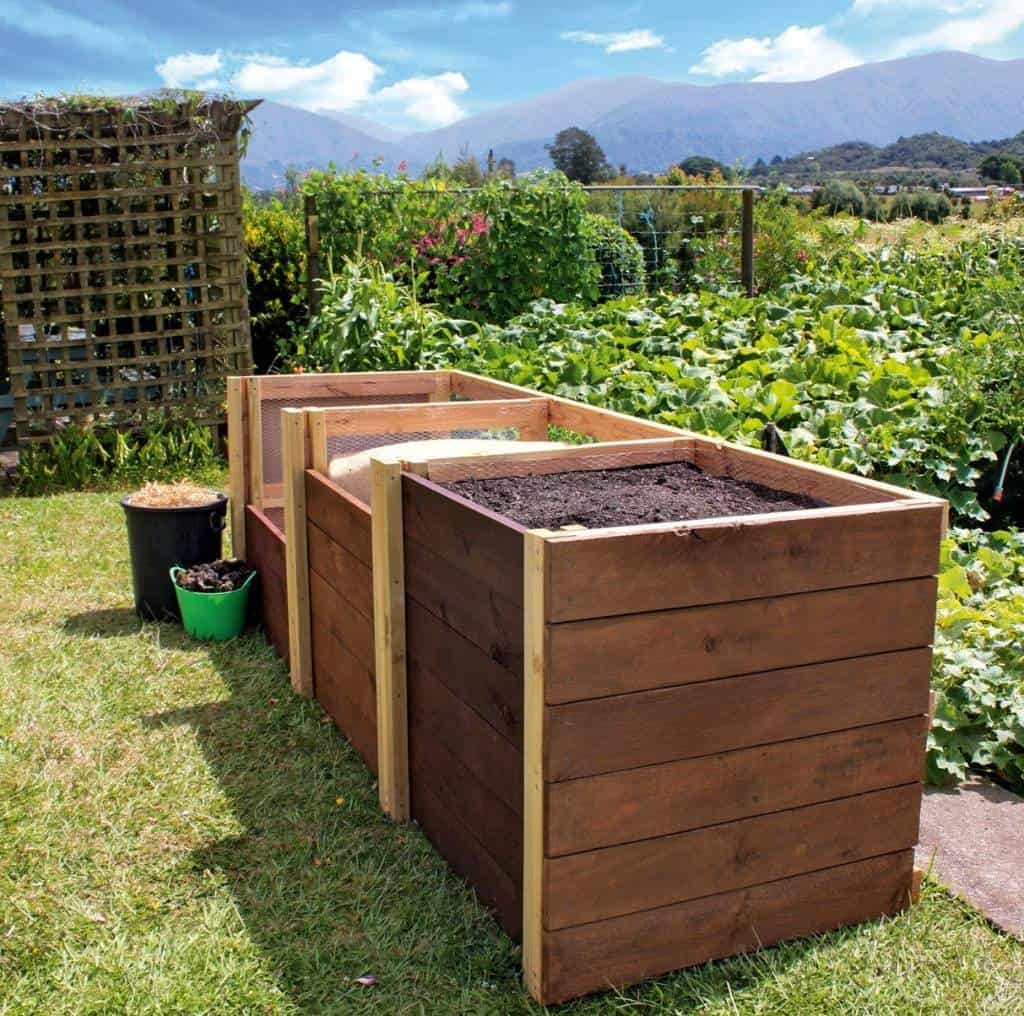DIY compost bins are more than just containers; they’re gateways to a sustainable lifestyle. Imagine transforming kitchen scraps and yard waste into nutrient-rich compost, a natural fertilizer that revitalizes your garden. Building your own compost bin is a rewarding experience, offering a sense of accomplishment and environmental responsibility.
This guide delves into the world of DIY compost bins, exploring everything from design choices to composting techniques. Whether you’re a seasoned gardener or a composting novice, this comprehensive resource will equip you with the knowledge and confidence to embark on your composting journey.
Design and Construction
Building a compost bin is a straightforward project that can be accomplished with readily available materials. The design and construction of your compost bin will influence its efficiency and ease of use. Several factors, such as the size, shape, and materials used, play a significant role in the composting process.
Types of Compost Bins
The type of compost bin you choose depends on your needs and preferences. Here are some common types:
- Three-bin system: This system consists of three bins, allowing you to manage different stages of composting. The first bin is for fresh materials, the second for active composting, and the third for finished compost.
- Tumbling composters: These bins have a rotating drum that mixes the compost materials, ensuring even decomposition. Tumbling composters are often made of plastic or metal.
- Static compost bins: These bins are stationary and can be made from various materials, such as wood, plastic, or metal. Static compost bins require turning the compost manually.
- Worm composting bins: Also known as vermicomposting, this method uses worms to break down organic waste. Worm composting bins are typically made of plastic or wood and are designed to provide a suitable environment for the worms.
Design Considerations
- Size: The size of your compost bin should be determined by the amount of organic waste you generate. A general rule of thumb is to have a bin that can hold about 3 cubic feet of material for a typical household.
- Shape: The shape of the compost bin can affect its efficiency. Square or rectangular bins are easier to build, while round or cylindrical bins provide better aeration.
- Ventilation: Adequate ventilation is crucial for the composting process. Ensure your bin has holes or openings to allow air to circulate.
- Drainage: Good drainage is essential to prevent waterlogging, which can hinder decomposition. The bin should have a bottom that allows excess water to drain away.
- Materials: The materials used for your compost bin should be durable and resistant to rot. Wood, plastic, and metal are all suitable options.
Building a Basic DIY Compost Bin
A simple and effective compost bin can be built using readily available materials. Here’s a step-by-step guide:
- Gather materials: You will need:
- Wood planks (4x4s for the frame and 1x6s for the sides)
- Screws or nails
- Power drill or hammer
- Measuring tape
- Level
- Saw
- Safety glasses
- Cut the wood: Cut the wood planks to the desired size for your compost bin. Ensure all sides are even and square.
- Assemble the frame: Use screws or nails to connect the 4x4s to form the base of the bin.
- Attach the sides: Secure the 1x6s to the frame, creating the sides of the bin.
- Add ventilation: Drill holes or cut openings in the sides of the bin to allow for air circulation.
- Add drainage: If desired, create a drainage system by attaching a piece of mesh or hardware cloth to the bottom of the bin.
- Finish: Apply a sealant or paint to protect the wood from the elements.
Troubleshooting Common Problems

Composting is a natural process, but sometimes things don’t go as smoothly as planned. This section addresses common problems you might encounter in your DIY compost bin and provides practical solutions to get your compost back on track.
Slow Decomposition
Slow decomposition is a common composting problem. Several factors can contribute to this, including:
- Insufficient Nitrogen: Nitrogen is essential for microbial activity, which breaks down organic matter. If your compost mix lacks nitrogen-rich materials like kitchen scraps, the decomposition process will slow down.
- Low Moisture Content: Compost needs to be moist, but not soggy. Too dry a compost will slow down microbial activity. Regularly check the moisture level and add water if needed.
- Lack of Aeration: Microbes need oxygen to thrive. If your compost bin is too compact or doesn’t have adequate air circulation, decomposition will slow down. Turn your compost regularly to introduce air.
- Incorrect Carbon-to-Nitrogen Ratio: The ideal carbon-to-nitrogen ratio for composting is around 30:1. Too much carbon (brown materials) can slow down decomposition.
- Cold Temperatures: Microbial activity slows down in cold temperatures. If you live in a cold climate, you may need to find ways to insulate your compost bin or use a hot composting method.
Foul Odors
Foul odors are a sign that anaerobic bacteria are thriving in your compost bin. Anaerobic bacteria thrive in the absence of oxygen and produce unpleasant smells. Here are some tips for preventing foul odors:
- Improve Aeration: Ensure your compost bin has adequate air circulation. Turn the compost regularly to introduce oxygen.
- Reduce Moisture: Excessive moisture can create an anaerobic environment. Check the moisture level of your compost and adjust accordingly.
- Avoid Adding Meat and Dairy: These materials decompose slowly and can attract pests. They can also create foul odors, especially in an anaerobic environment.
- Add More Brown Materials: Brown materials like leaves and straw help to balance the carbon-to-nitrogen ratio and reduce moisture levels.
Pests
Pests can be a nuisance in compost bins, but they are often attracted by the same factors that cause slow decomposition and foul odors. Here are some tips for preventing and dealing with pests:
- Keep Compost Bin Covered: A covered compost bin will deter pests and prevent unwanted materials from getting in.
- Avoid Adding Meat and Dairy: These materials attract pests like rodents and flies.
- Use a Compost Tea: Compost tea is a liquid solution made from compost that can be sprayed around your compost bin to deter pests.
- Consider a Worm Bin: Worms can help to break down organic matter and control pests.
Variations and Enhancements: Diy Compost Bin
The basic DIY compost bin design can be modified to suit your needs and environment. This section explores alternative composting methods, tips for improving efficiency, and considerations for urban settings.
Alternative Composting Methods
Beyond the traditional bin design, several other composting methods are available. Each method has its own advantages and disadvantages, catering to different needs and preferences.
- Worm Composting: Also known as vermicomposting, this method utilizes earthworms to break down organic waste. Worms are highly efficient decomposers, producing a nutrient-rich compost called vermicast. Vermicomposting is ideal for smaller quantities of food scraps and can be done indoors in a bin or container.
- Bokashi Composting: Bokashi is a fermented composting method using a mixture of effective microorganisms (EM) and bran. This method breaks down organic matter quickly, even including meat and dairy products. Bokashi composting results in a fermented material rather than traditional compost, which can be used as a soil amendment or fertilizer.
Enhancing Composting Efficiency
Composting efficiency can be improved through various techniques, ensuring faster decomposition and nutrient-rich compost.
- Compost Activators: These products contain beneficial microorganisms that accelerate decomposition. They can be added to the compost bin to enhance microbial activity.
- Adding Beneficial Microbes: Introducing beneficial microbes, such as compost tea or worm castings, can significantly improve compost quality. These microbes contribute to faster decomposition and nutrient enrichment.
- Maintaining Optimal Moisture Levels: Keeping the compost bin moist, but not soggy, is crucial for microbial activity. Too much moisture can lead to anaerobic decomposition, producing foul odors.
- Turning the Compost: Regularly turning the compost pile ensures even aeration and promotes microbial activity. This also helps break down larger pieces of material and prevents clumping.
Composting in Urban Settings
Composting is becoming increasingly popular in urban areas, with limited space and unique challenges.
- Balcony Composting: Compact compost bins or tumblers can be placed on balconies, allowing urban dwellers to compost their food scraps. These bins are typically smaller in size and designed for limited space.
- Vermicomposting: Worm composting is particularly suitable for urban settings, as it can be done indoors in a container or bin. Vermicomposting is space-efficient and can be easily managed in apartments or small homes.
Sustainability and Environmental Impact

Composting is an environmentally friendly practice that offers numerous benefits. It diverts organic waste from landfills, reduces greenhouse gas emissions, and enriches soil fertility. By building a DIY compost bin, you actively contribute to a more sustainable lifestyle and minimize your environmental footprint.
Benefits of Composting
Composting plays a crucial role in reducing waste and promoting sustainability. Here are some key benefits:
- Reduces Landfill Waste: Organic materials like food scraps and yard waste make up a significant portion of landfill waste. Composting diverts these materials from landfills, reducing their volume and minimizing the environmental impact associated with waste disposal.
- Reduces Greenhouse Gas Emissions: When organic waste decomposes in landfills, it releases methane, a potent greenhouse gas that contributes to climate change. Composting helps mitigate these emissions by allowing organic materials to break down in a controlled environment, producing less methane.
- Enhances Soil Fertility: Compost is a rich source of nutrients that improve soil structure, water retention, and microbial activity. It helps create a healthier and more productive growing environment for plants.
- Conserves Resources: Composting reduces the need for synthetic fertilizers and soil amendments, which are often produced using energy-intensive processes and contribute to environmental pollution.
Minimizing the Environmental Impact of Composting
While composting is an environmentally beneficial practice, it’s essential to minimize its environmental impact:
- Avoid Using Plastic or Non-Biodegradable Materials: Avoid using plastic bags or other non-biodegradable materials in your compost bin. These materials can contaminate the compost and persist in the environment for a long time.
- Properly Manage Compost Tea: Compost tea, a liquid extract of compost, can be a valuable fertilizer. However, it’s crucial to manage it properly to prevent nutrient runoff and potential water pollution.
- Choose Locally Sourced Materials: Whenever possible, use locally sourced materials for your compost bin construction. This reduces transportation distances and associated emissions.
Closing Notes
By embracing the art of DIY composting, you’re not only enriching your garden but also contributing to a healthier planet. The journey from kitchen scraps to garden gold is both practical and fulfilling, a testament to the power of sustainable living. As you witness the magic of decomposition and the transformation of waste into valuable resources, you’ll gain a deeper appreciation for the interconnectedness of nature and the role we play in its preservation.
A DIY compost bin is a great way to reduce waste and create nutrient-rich soil for your garden. It’s a rewarding project, much like finding a great DIY car wash near me to keep your vehicle sparkling clean. After all, a clean car and a healthy garden are both satisfying achievements that come from putting in a little effort.